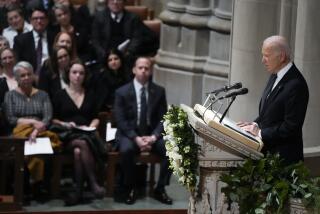First Lady, Democratic Leader Helped Miers
- Share via
WASHINGTON — When Harriet E. Miers sat down Sunday for supper with President Bush in the private quarters of the White House, she had an influential ally at the table: Laura Bush.
Twice this summer, Mrs. Bush had publicly expressed the hope that her husband would name a woman to replace Sandra Day O’Connor, the first woman to serve on the Supreme Court.
Before the dinner of fried shrimp, polenta and chocolate mousse was over, the first lady’s wish came true. Bush’s nomination offer to Miers brought to a surprising end a professional courtship between the president and his White House counsel that he launched discreetly less than two weeks earlier.
“I don’t think this was something that she expected,” said White House Press Secretary Scott McClellan. “She was not seeking this out.”
Indeed, Miers was among the top White House aides who were vetting potential candidates for the court, and her name was put forward by an unusual source -- the leader of the Senate Democrats, Harry Reid of Nevada.
On Sept. 21, during a breakfast meeting with Bush and other senators, Reid suggested that Miers would make a good nominee, citing his favorable impression of her during the confirmation process for the new chief justice, John G. Roberts Jr.
In addition, senators of both parties were urging Bush to consider a nominee who has never served as a judge. Such a candidate, they said, would bring different experiences and perspectives to a court whose members had risen through the ranks of the judiciary.
The same day that Reid suggested Miers as a potential justice, Bush broached the topic with her. She was, said McClellan, one of as many as 15 candidates the president considered -- “a diverse” group from “all walks of life,” including at least half a dozen women.
Bush and Miers talked again Wednesday and Thursday. White House officials began sounding out some conservative allies as early as Thursday, testing their reaction to Miers and two other possibilities, according to Paul M. Weyrich, head of the conservative Free Congress Foundation.
Bush continued pondering the matter during the weekend at Camp David, the presidential retreat in Maryland’s Catoctin Mountains. There, he conferred several times with White House chief of staff Andrew H. Card Jr.
The president returned to the White House on Sunday morning for an annual church service honoring the legal profession on the day before the Supreme Court’s new term. “He’s still working ... still considering lots of options,” Card told reporters as Bush got off Marine One.
By 7 p.m., Bush told Card of his decision, and Card called Vice President Dick Cheney.
In the end, McClellan said Monday, Bush recognized Miers as “someone who had the kind of qualifications and experience and judgment that was needed to serve.”
On Monday morning at 7, an hour before he announced Miers as his choice, Bush called the new chief justice to inform him of the nomination. Then the president called O’Connor. A short time later, he attended Roberts’ investiture.
Bush initially had selected Roberts to succeed O’Connor, who at the time rued that her seat would not be filled by a woman. But when Chief Justice William H. Rehnquist died a month ago, Bush nominated Roberts to be chief justice.
In selecting Miers to succeed O’Connor, Bush clearly made his wife happy. As Susan Whitson, the first lady’s press secretary, noted, “Mrs. Bush is pleased with the pick.”
“The president certainly takes into account her advice, I can assure you of that,” added McClellan.
Times staff writers Mary Curtius and Maura Reynolds contributed to this report.
More to Read
Get the L.A. Times Politics newsletter
Deeply reported insights into legislation, politics and policy from Sacramento, Washington and beyond. In your inbox twice per week.
You may occasionally receive promotional content from the Los Angeles Times.










